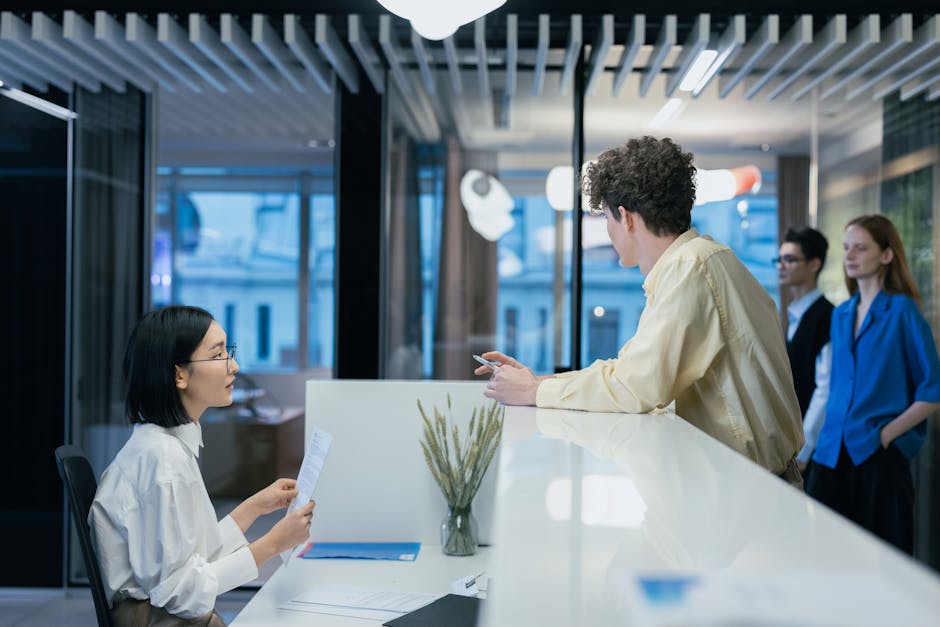Reimagining Workplace Design: Creating Spaces That Inspire and Perform
“Workplace design has evolved from merely arranging desks to becoming a strategic tool that embodies company culture, enhances productivity, and supports employee wellbeing. This article explores the latest trends in workplace design, highlighting how thoughtful spaces can serve as key differentiators in talent attraction and retention while supporting the needs of a diverse, technology-savvy workforce. ”

Reimagining Workplace Design: Creating Spaces That Inspire and Perform
In today's rapidly evolving business landscape, workplace design has emerged as a critical factor in shaping organizational success. No longer just about arranging desks and chairs, modern workplace design has become a strategic tool that embodies company culture, enhances productivity, and supports employee wellbeing. As we navigate the complexities of hybrid work models and changing employee expectations, creating thoughtful, intelligent workplace environments has become a key differentiator for businesses looking to attract and retain top talent.

The Evolution of Workplace Design
Workplace design has undergone a remarkable transformation over the past decade. Traditional office layouts with rigid cubicles and corner offices have given way to more flexible, dynamic spaces that accommodate diverse work styles and activities. This evolution reflects broader changes in how we work, communicate, and collaborate.
Several factors have contributed to this workplace makeover:
- The rise of technology-savvy generations entering the workforce
- Increasing emphasis on collaboration and innovation
- Growing awareness of how physical environments impact mental health and productivity
- The shift toward hybrid and remote work models following the global pandemic
As Partner and Practice Leader at Little, Eddie drives workplace design excellence while shaping the future of the Workplace Practice. According to experts like him, workplace design now focuses on creating environments that inspire employees and reinforce organizational values rather than simply providing a place to work.
Key Elements of Effective Workplace Design
Brand Identity and Culture Integration
Workplace design should be the embodiment of a company's culture and clearly communicate its values to employees, clients, and partners. When physical spaces align with organizational identity, they reinforce brand messaging and create a cohesive experience for everyone who enters the space.
Effective cultural integration in workplace design might include:
- Visual elements that reflect company history and achievements
- Spaces designed around core company values (e.g., collaboration zones for team-oriented cultures)
- Environmental graphics and signage that communicate brand personality
- Materials and finishes that align with brand aesthetics
Balance Between Collaboration and Focus
One of the greatest challenges in modern workplace design is striking the right balance between collaborative spaces and areas for focused work. The most successful designs recognize that employees need both types of environments to perform effectively.
This balance typically includes:
- Open collaboration zones with flexible furniture arrangements
- Private focus rooms or pods for concentrated work
- Semi-private areas for small group discussions
- Acoustic solutions that manage noise levels in different zones
Technology Integration
Today's workplaces must seamlessly integrate technology to support modern work processes. This goes beyond simply providing Wi-Fi and power outlets – it means creating environments where digital and physical experiences complement each other.
Key technology considerations include:
- Room booking systems for meeting spaces
- Video conferencing capabilities in collaboration areas
- Digital wayfinding solutions
- Smart building features for lighting, temperature, and space utilization
Emerging Trends in Workplace Design
Biophilic Design Elements
Incorporating natural elements into workplace design has moved from a nice-to-have feature to an essential component of healthy work environments. Biophilic design – which connects occupants to nature – has been shown to reduce stress, enhance creativity, and improve overall wellbeing.
Biophilic elements commonly include:
- Natural materials like wood and stone
- Living walls and indoor plants
- Abundant natural light
- Views of outdoor landscapes where possible
- Water features and natural soundscapes
Flexibility and Adaptability
The most forward-thinking workplace designs prioritize flexibility, allowing spaces to evolve as organizational needs change. This adaptability has become particularly important as companies navigate hybrid work models and fluctuating office occupancy.
Flexible design approaches include:
- Modular furniture systems that can be reconfigured
- Movable walls and partitions
- Multi-purpose spaces that serve different functions throughout the day
- Unassigned seating arrangements that adapt to changing team sizes

Wellness-Focused Environments
Employee wellbeing has become a central consideration in workplace design, with organizations recognizing the connection between healthy environments and productivity. Wellness-focused design goes beyond ergonomics to address physical, mental, and emotional health.
Key wellness features include:
- Ergonomic furniture that supports proper posture
- Spaces dedicated to relaxation and mindfulness
- Fitness areas or access to physical activity
- Healthy food options and hydration stations
- Air quality management systems
Designing for the Future of Work
Supporting Hybrid Work Models
As organizations embrace hybrid work strategies, workplace design must evolve to support employees who split their time between remote and in-office work. This requires thoughtful consideration of how physical spaces can complement and enhance remote work experiences.
Effective hybrid-supportive design includes:
- Technology that connects in-office and remote workers seamlessly
- Bookable workstations and meeting rooms
- Collaboration spaces designed for hybrid meetings
- Social areas that foster connection when employees are on-site
Creating Move-In-Ready Spaces
One interesting trend noted by workplace design experts is the increasing demand for move-in-ready interior suites designed for speculative tenants. Landlords are partnering with designers to create efficient spaces based on proven workplace design principles, even before securing tenants.
These pre-designed spaces typically feature:
- Flexible floor plans that work for various industries
- Pre-installed technology infrastructure
- High-quality finishes that appeal to a broad range of tenants
- Sustainable design elements that meet modern expectations
Sustainability Integration
From repurposing vacant spaces to creating ecosystems that go beyond office walls, sustainability is becoming integral to workplace design. Organizations are increasingly seeking spaces that align with their environmental values and help them meet corporate sustainability goals.
Sustainable design approaches include:
- Energy-efficient lighting and HVAC systems
- Recycled and renewable materials
- Waste reduction strategies
- Water conservation features
- Spaces that can be easily adapted rather than demolished and rebuilt
The Impact of Workplace Design on Business Outcomes
Employee Engagement and Retention
Thoughtful workplace design has emerged as a powerful tool for talent attraction and retention. As we experience what many call "The Great Resignation" globally, organizations are reconsidering how their physical environments can help engage and retain valuable employees.
Research consistently shows that well-designed workplaces contribute to:
- Higher employee satisfaction and engagement
- Stronger organizational commitment
- Reduced turnover rates
- Better recruitment outcomes, especially among younger generations
Productivity and Performance
JLL's latest workplace design studies reveal that office design can significantly increase employee performance, especially for technology-savvy generations. The physical environment directly impacts how efficiently and effectively people can work.
Design elements that enhance productivity include:
- Appropriate lighting (particularly natural light)
- Noise management solutions
- Temperature and air quality control
- Spaces that support different work modes and tasks
- Intuitive wayfinding that reduces time spent navigating the office

Supporting Neurodiversity
Progressive workplace design now considers neurodiversity – recognizing that people process information and interact with their environments differently. Creating spaces that accommodate diverse neurological conditions helps ensure all employees can perform at their best.
Neurodiverse-friendly design features might include:
- Quiet zones with reduced sensory stimulation
- Options for different lighting levels
- Alternative seating arrangements
- Clear wayfinding and signage
- Spaces with varying levels of privacy and openness
Implementing Effective Workplace Design
Understanding User Needs
The foundation of successful workplace design is a deep understanding of how employees actually work and what they need to perform effectively. This requires going beyond assumptions to gather real data and insights.
Effective approaches include:
- Employee surveys and interviews
- Observation studies of how spaces are currently used
- Utilization data from sensors or booking systems
- Pilot projects to test new concepts before full implementation
Balancing Aesthetics and Functionality
While visual appeal is important, the most successful workplace designs balance aesthetics with practical functionality. Beautiful spaces that don't support the work being done will ultimately fail, regardless of how Instagram-worthy they might be.
This balance requires:
- Prioritizing user needs over design trends
- Selecting materials and finishes that are both attractive and durable
- Ensuring furniture is both visually appealing and comfortable
- Creating spaces that photograph well but also work well in daily use
Measuring Success
To ensure workplace design investments deliver value, organizations should establish clear metrics for success and regularly evaluate performance against these benchmarks.
Useful measurement approaches include:
- Space utilization tracking
- Employee satisfaction surveys
- Productivity metrics before and after design changes
- Energy consumption and sustainability performance
- Health and wellbeing indicators
Conclusion: The Future of Workplace Design
As we look ahead, workplace design will continue to evolve in response to changing work patterns, technological advancements, and employee expectations. The most successful organizations will view their physical environments as strategic assets that can drive business performance, enhance culture, and support employee wellbeing.
The future workplace will likely be characterized by:
- Even greater flexibility and adaptability
- Seamless integration of physical and digital experiences
- Increased focus on sustainability and wellness
- Spaces designed to foster human connection in an increasingly digital world
- Personalization that accommodates diverse preferences and work styles
By investing in thoughtful, strategic workplace design, organizations can create environments that not only accommodate work but actively enhance it – turning physical space into a competitive advantage in the ongoing battle for talent and market leadership.
For organizations navigating workplace design decisions, the key is to start with a clear understanding of organizational culture and employee needs, then create spaces that authentically reflect these realities while supporting future growth and adaptation. In doing so, they can transform their workplaces from mere cost centers into valuable assets that drive business success.